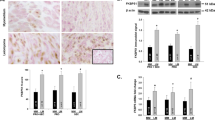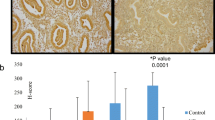Abstract
The pathogenesis of leiomyoma may be related to an imbalance in the interaction of sex steroids with paracrine growth factors that may control the modulation of mitogenesis and local immunity. The authors investigate the temporal and spatial expression of proliferative and preapoptotic molecules that may participate in the modulation of myometrial function and leiomyoma pathogenesis. Immunohistochemistry and Western blot analysis are used to investigate Fas ligand (FasL), phosphatase and tensin homolog deletion on chromosome 10 (PTEN), and proliferating cell nuclear antigen (PCNA) expression in myometrium and leiomyoma. Western blot results show that in the secretory phase, FasL expression is 1.8-fold and 2.3-fold higher compared with the proliferative phase in the myometrium and leiomyoma, respectively (P =.022 and.047, respectively). A paired comparison between myometrium and leiomyoma reveals higher FasL expression in the leiomyoma (P =.003). On the contrary, when compared with the secretory phase, PCNA expression during the proliferative phase is 4.6-fold and 3.7-fold higher in the myometrium and leiomyoma, respectively (P =.041 and.034, respectively). A paired comparison between myometrium and leiomyoma reveals higher PCNA expression in the leiomyoma. Furthermore, lower PTEN expression is detected in the leiomyoma compared with the myometrium (P <.032). Immunohistochemistry results reveal that FasL, PTEN, and PCNA are expressed in the myometrium and leiomyoma, consistent with the results from the Western blot analysis. The results suggest that FasL, PTEN, and PCNA may be involved in the pathophysiology of leiomyoma. A higher FasL level in the leiomyoma is likely to correspond to suppression of local immunity by inducing apoptosis of immune cells, while a higher level of PCNA and a lower level of PTEN may be related to increased mitogenesis and decreased apoptosis in leiomyoma.
Similar content being viewed by others
References
Kierszenbaum A. Follicle development and menstrual cycle: uterus. In: Histology and Cell Biology: An Introduction to Pathology. St Louis, MO:Mosby; 2002:565–585.
Flake GP, Andersen J., Dixon D. Etiology and pathogenesis of uterine leiomyomas: a review. Environ Health Perspect. 2003;111:1037–1054.
Sozen I., Arici A. Cellular biology of myomas: interaction of sex steroids with cytokines and growth factors. Obstet Gynecol Clin North Am. 2006;33:41–58.
Palomba S., Orio F. Jr, Russo T., et al. Antiproliferative and proapoptotic effects of raloxifene on uterine leiomyomas in postmenopausal women. Fertil Steril. 2005;84:154–161.
Wei JJ, Zhang XM, Chiriboga L., Yee H., Perle MA, Mittal K. Spatial differences in biologic activity of large uterine leiomyomata. Fertil Steril. 2006;85:179–187.
Sozen I., Arici A. Interactions of cytokines, growth factors, and the extracellular matrix in the cellular biology of uterine leiomyomata. Fertil Steril. 2002;78:1–12.
Liang M., Wang H., Zhang Y., Lu S., Wang Z. Expression and functional analysis of platelet-derived growth factor in uterine leiomyomata. Cancer Biol Ther. 2006;5:28–33.
Cramer SF, Horiszny JA, Leppert P. Epidemiology of uterine leiomyomas: with an etiologic hypothesis. J Reprod Med. 1995;40:595–600.
Nagata S., Golstein P. The Fas death factor. Science. 1995;267:1449–1456.
Leslie NR, Downes CP PTEN: the down side of PI 3-kinase signalling. Cell Signal. 2002;14:285–295.
Han SY, Kato H., Kato S., et al. Functional evaluation of PTEN missense mutations using in vitro phosphoinositide phosphatase assay. Cancer Res. 2000;60:3147–3151.
Myers MP, Pass I., Batty IH, et al.The lipid phosphatase activity of PTEN is critical for its tumor suppressor function. Proc Natl Acad Sci U S A. 1998;95:13513–13518.
Majka J., Burgers PM The PCNA-RFC families of DNA clamps and clamp loaders. Prog Nucleic Acid Res Mol Biol. 2004;78:227–260.
Maga G., Hubscher U. Proliferating cell nuclear antigen (PCNA): a dancer with many partners. J Cell Sci. 2003;116:3051–3060.
Goumenou A., Panayiotides I., Mahutte NG, Matalliotakis I., Fragouli Y., Arici A. Immunohistochemical expression of p53, MDM2, and p21Waf1 oncoproteins in endometriomas but not adenomyosis. J Soc Gynecol Investig. 2005;12:263–266.
Goumenou AG, Matalliotakis IM, Tzardi M., Fragouli YG, Mahutte NG, Arici A. Apoptosis and differential expression of apoptosis-related proteins in endometriotic glandular and stromal cells. J Soc Gynecol Investig. 2004;11:318–322.
Noyes RW, Hertig AT, Rock J. Dating the endometrial biopsy. Am J Obstet Gynecol. 1975;122:262–263.
Kayisli UA, Selam B., Demir R., Arici A. Expression of vasodilator-stimulated phosphoprotein in human placenta: possible implications in trophoblast invasion. Mol Hum Reprod. 2002;8:88–94.
Cook JD, Walker CL. Treatment strategies for uterine leiomyoma: the role of hormonal modulation. Semin Reprod Med. 2004;22:105–111.
Burroughs KD, Kiguchi K., Howe SR, et al. Regulation of apoptosis in uterine leiomyomata. Endocrinology. 1997;138:3056–3064.
Shynlova O., Oldenhof A., Dorogin A., et al. Myometrial apoptosis: activation of the caspase cascade in the pregnant rat myometrium at midgestation. Biol Reprod. 2006;74:839–849.
Huang SC, Tang MJ, Hsu KF, Cheng YM, Chou CY Fas and its ligand, caspases, and bcl-2 expression in gonadotropin-releasing hormone agonist-treated uterine leiomyoma. J Clin Endocrinol Metab. 2002;87:4580–4586.
Wang Y., Matsuo H., Kurachi O., Maruo T. Down-regulation of proliferation and up-regulation of apoptosis by gonadotropin-releasing hormone agonist in cultured uterine leiomyoma cells. Eur J Endocrinol. 2002;146:447–456.
Maruo T., Ohara N., Wang J., Matsuo H. Sex steroidal regulation of uterine leiomyoma growth and apoptosis. Hum Reprod Update. 2004;10:207–220.
Selam B., Kayisli UA, Mulayim N., Arici A. Regulation of Fas ligand expression by estradiol and progesterone in human endometrium. Biol Reprod. 2001;65:979–985.
Bourlev V., Pavlovitch S., Stygar D., Volkov N., Lindblom B., Olovsson M. Different proliferative and apoptotic activity in peripheral versus central parts of human uterine leiomyomas. Gynecol Obstet Invest. 2003;55:199–204.
Kawaguchi K., Fujii S., Konishi I., Nanbu Y., Nonogaki H., Mori T. Mitotic activity in uterine leiomyomas during the menstrual cycle. Am J Obstet Gynecol. 1989;160:637–641.
Shimomura Y., Matsuo H., Samoto T., Maruo T. Up-regulation by progesterone of proliferating cell nuclear antigen and epidermal growth factor expression in human uterine leiomyoma. J Clin Endocrinol Metab. 1998;83:2192–2198.
Lamminen S., Rantala I., Helin H., Rorarius M., Tuimala R. Proliferative activity of human uterine leiomyoma cells as measured by automatic image analysis. Gynecol Obstet Invest. 1992;34:111–114.
Zaslawski R., Surowiak P., Dziegiel P., Pretnik L., Zabel M. Analysis of the expression of estrogen and progesterone receptors, and of PCNA and Ki67 proliferation antigens, in uterine myomata cells in relation to the phase of the menstrual cycle. Med Sci Monit. 2001;7:908–913.
Chegini N., Verala J., Luo X., Xu J., Williams RS Gene expression profile of leiomyoma and myometrium and the effect of gonadotropin releasing hormone analogue therapy. J Soc Gynecol Investig. 2003;10:161–171.
Dixon D., Flake GP, Moore AB, et al. Cell proliferation and apoptosis in human uterine leiomyomas and myometria. Virchows Arch. 2002;441:53–62.
Buttram VC Jr, Reiter RC Uterine leiomyomata: etiology, symptomatology, and management. Fertil Steril. 1981;36:433–445.
Mutter GL, Ince TA, Baak JP, Kust GA, Zhou XP, Eng C. Molecular identification of latent precancers in histologically normal endometrium. Cancer Res. 2001;61:4311–4314.
Guzeloglu-Kayisli O., Kayisli UA, Al-Rejjal R., Zheng W., Luleci G., Arici A. Regulation of PTEN (phosphatase and tensin homolog deleted on chromosome 10) expression by estradiol and progesterone in human endometrium. J Clin Endocrinol Metab. 2003;88:5017–5026.
Kovacs KA, Lengyel F., Kornyei JL, et al. Differential expression of Akt/protein kinase B, Bcl-2 and Bax proteins in human leiomyoma and myometrium. J Steroid Biochem Mol Biol. 2003;87:233–240.
Wei J., Chiriboga L., Mizuguchi M., Yee H., Mittal K. Expression profile of tuberin and some potential tumorigenic factors in 60 patients with uterine leiomyomata. Mod Pathol. 2005;18:179–188.
Hussein-Fikret S., Fuller PJ, Gargett CE Expression of steroid receptor coactivators in cultured cells from paired myometrial and fibroid tissues. J Soc Gynecol Investig. 2005;12:445–451.
Author information
Authors and Affiliations
Corresponding author
Rights and permissions
About this article
Cite this article
Kayisli, U.A., Berkkanoglu, M., Kizilay, G. et al. Expression of Proliferative and Preapoptotic Molecules in Human Myometrium and Leiomyoma Throughout the Menstrual Cycle. Reprod. Sci. 14, 678–686 (2007). https://doi.org/10.1177/1933719107305866
Published:
Issue Date:
DOI: https://doi.org/10.1177/1933719107305866




